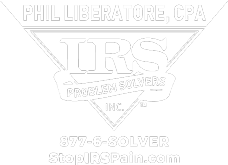Phil L. Liberatore CPA, A Professional Corporation is working hard to keep you informed and up to date on current tax and accounting news potentially affecting you, your families and your business.
THE TAX REFORM BILL PASSED CONGRESS
– What should I do?
Congress has put a bow on the biggest tax cut bill since 1986.It is estimated that 80% of tax payers will see some form of a reduction in their tax bill.
The legislation will go into effect Jan. 1, 2018. Tax filings for the 2017 year will largely resemble your 2016 tax return.
OUR RECOMMENDATIONS:
- Take a close look at your state income taxes that could be due for 2017. If you own your home and itemize your tax deductions, consider winter property tax bill by December 31, 2017. If you typically owe state income taxes, consider making an estimated tax payment by the end of December. The state and local income tax deductions will be limited to $10,000 in 2018.
To get an idea of what you paid for these taxes in 2016, refer to your 2016 taxes SCHEDULE A of form 1040, lines 5-8.
EXAMPLE: If your total state and local tax deduction for 2016 was 12,000, you will only be able to take up to $10,000 in deductions for 2018.
- Maximize your charitable organization donations. If you and your family have gotten in the habit of giving charitably, consider making your donation by December 31, 2017. This may also include ‘in-kind’ donations such as cars, etc.
- Consider paying down your home equity loans.They will no longer be deductible in 2018.
- Consider making a mortgage payment before December 31, 2017. This will increase your mortgage interest deduction for 2017.
- Prepare all of your 2017 miscellaneous tax deductions. They are being phased out in 2018. This includes unreimbursed work-related expenses, home office expenses, and tax preparation expenses. Have them ready for your tax return.
- Pay your medical bills. If you itemize, and have significant medical expenses, consider paying your medical bills. The threshold for medical expenses has actually been lowered for 2017 – 2018 to 7.5%.
FOR INDIVIDUALS:
1. Lowers (many) individual rates: The bill preserves seven tax brackets, but changes the rates that apply to: 10%, 12%, 22%, 24%, 32%, 35% and 37%.
Today’s rates are 10%, 15%, 25%, 28%, 33%, 35% and 39.6%.
Here’s how income tax brackets will align according to the new rates:
– 10% (income up to $9,525 for individuals; up to $19,050 for married couples filing jointly)
– 12% (over $9,525 to $38,700; over $19,050 to $77,400 for couples)
– 22% (over $38,700 to $82,500; over $77,400 to $165,000 for couples)
– 24% (over $82,500 to $157,500; over $165,000 to $315,000 for couples)
– 32% (over $157,500 to $200,000; over $315,000 to $400,000 for couples)
– 35% (over $200,000 to $500,000; over $400,000 to $600,000 for couples)
– 37% (over $500,000; over $600,000 for couples)
The effect: It’s expected that the Treasury Department will come out with withholding tables in January, taxpayers might see the effect in their paychecks in February 2018.
2. Capital gains tax rates remain largely unchanged:The system for taxing capital gains and qualified dividends did not change under the act but the brackets will be adjusted.
3. Nearly doubles the standard deduction: For single filers, the bill increases it to $12,000 from $6,350 currently; for married couples filing jointly it increases to $24,000 from $12,700.
The effect: The percentage of filers who choose to itemize would drop sharply, since the only reason to do so is if your deductions exceed your standard deduction.
4. Eliminates personal exemptions: Today you’re allowed to claim a $4,050 personal exemption for yourself, your spouse and each of your dependents. Doing so lowers your taxable income and thus your tax burden. The tax bill eliminates that option.
The effect: For families with three or more kids, that could mute if not negate any tax relief they might get as a result of other provisions in the bill.
5. Expands child tax credit: The credit is doubled to $2,000 for children under 17. It also would be made available to high earners because the bill would raise the income threshold under which filers may claim the full credit to $200,000 for single parents, up from $75,000 today; and to $400,000 for married couples, up from $110,000 today.
The effect: More Families will be able to get refundable child tax credits.
6. Eliminates mandate to buy health insurance:There would no longer be a penalty for not buying health insurance.
7. Changes to Itemized Deductions:
- Caps the state and local tax deduction: the final bill limits the state and local tax deduction for anyone who itemizes at $10,000. *For 2017 the deduction is unlimited for your state and local property taxes plus income or sales taxes.
The effect: If you own your home and itemize your tax deductions, you may be effected by this change, follow our recommendation on paying both real estate installments and any other state taxes you may be subject to in 2017. To get an idea of what you paid for these taxes in 2016, see your 2016 taxes SCHEDULE A of form 1040, lines 5-8.
EXAMPLE: if your total state and local tax deduction for 2017 will be 12,000, you will only be able to take $10,000 in deductions for 2018.
- Lowers cap on mortgage interest deduction: If you take out a new mortgage on a first or second home you would only be allowed to deduct the interest on debt up to $750,000, down from $1 million today. The bill would no longer allow a deduction for the interest on home equity loans, currently that’s allowed on loans up to $100,000.
The effect: Homeowners who already have a mortgage would be unaffected by the change. New mortgages taken after December 15 2018 will be fall under the limitation.
- No Major changes to the charitable donation deduction: The charitable donation deduction will remain in place with some adjustments upwards on limits for cash gifts. The charitable mileage rate will remain 14 cents per mile.
The effect: Currently, if you itemize your deductions, you can deduct certain donations to qualified charitable organizations.
- Miscellaneous itemized deductions: All miscellaneous itemized deductions subject to the 2% floor under current law are repealed.
The effect: Taxpayers who normally claim significant miscellaneous expenses (e.g. unreimbursed work-related expenses, home office expenses, and tax preparation expenses) will not be able to claim them anymore.
- Medical expenses: The act reduced the threshold for deduction of medical expenses to 7.5% of adjusted gross income for 2017 and 2018.
The medical expense deduction will remain in place with a lower floor of 7.5% for tax years 2017 and 2018. That means it is retroactive to 2017.
8. Curbs who’s hit by AMT: The AMT (Alternative Minimum Tax) is a secondary tax put in place in the 1960s to prevent the wealthy from artificially reducing their tax bill through the use of tax preference items. It is reduced by raising the income exemption levels to $70,300 for singles, up from $54,300 today; and to $109,400, up from $84,500, for married couples.
9. 529 College savings plans are expanded: Under the passed bill, up to $10,000 of 529 savings plans can be used per student for public, private and religious elementary and secondary schools, as well as home school students.
10. No changes to the college and tuition credits: The American Opportunity Credit (AOC) and Lifetime Learning Credit (LLC) remain unchanged under the passed bill.
11. No change to the exclusion of gain from sale of your home: There are no changes to the current law, you can still exclude up to $250,000 ($500,000 for married taxpayers) in capital gains from the sale of your home so long as you have owned and resided in the house for at least two of the last five years.
12. Exempts almost everybody from the estate tax: The tax bill essentially eliminates estate tax for all but the smallest number of people by doubling the amount of money exempt from the estate tax – currently set at $5.49 million for individuals, and $10.98 million for married couples. This measure will likely affect owners of businesses and farms who pass on those assets to their children.
FOR BUSINESSES:
- Corporate Tax Relief: Under the passed bill, the corporate tax rate would be lowered to 21% (presently 35%) beginning in January 1 2018. This will effect Corporations which do not pass through their income pay tax on profits at the corporate level.
- Pass-Through Entities: Businesses use structures like limited liability companies (LLCs) or S corporations to pass income through to the owners without paying tax at the company level. Under the passed bill, owners of pass-through companies (e.g. S corporations, partnerships, and LLCs) and sole proprietors will be taxed at their individual tax rates less a 20% deduction (to bring the rate lower) for business-related income (subject to certain wage limits and exceptions). Phase-ins begin at $157,500 for individual taxpayers and $315,000 for married taxpayers filing jointly.
Please contact me with any questions or concerns as I will strategize to ensure that you maximize your tax savings.
Sincerely,
Phil Liberatore





